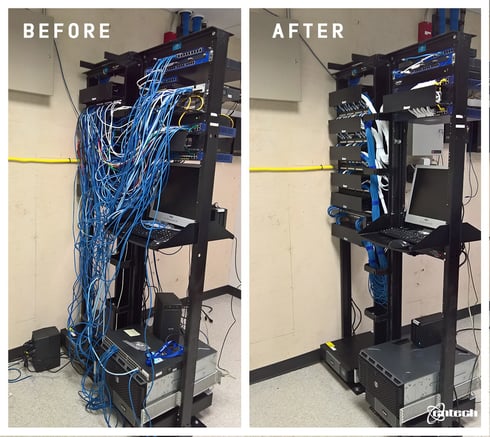
Your server room is a big indicator of the health of your network. Whether you’re working with an internal IT department or an outsourced provider, attention should be paid to the overall organization and structure of your server room. While we outlined some of the biggest hazards in our recent blog “Is your Server Room a Fire Hazard?” there are many other aspects of your server room that you should be paying attention to as well. Here are 7 server room best practices for small and medium-sized businesses that will help identify red flags and keep things organized, clean and hazard-free.
- Organized Cabling
 This is one of the biggest problems that we see when we walk into prospect server rooms to do our initial assessment. The organization of cabling from each piece of equipment is really important from a troubleshooting perspective. It’s not just about the aesthetics (though it helps significantly). It’s almost impossible to fix, disconnect or test things if the cabling is a mess. Organized cabling is the sign of a diligent IT provider who is considering long term.
This is one of the biggest problems that we see when we walk into prospect server rooms to do our initial assessment. The organization of cabling from each piece of equipment is really important from a troubleshooting perspective. It’s not just about the aesthetics (though it helps significantly). It’s almost impossible to fix, disconnect or test things if the cabling is a mess. Organized cabling is the sign of a diligent IT provider who is considering long term.
- Labeling
Another thing that makes troubleshooting simpler is the labeling of all servers, firewalls, switches, routers, modems and other network and security equipment as well as important ports on your patch panels. Proper, detailed labeling will help any other technician that comes in unfamiliar with your network to easily troubleshoot without having to have a network diagram (though one should always be available from a documentation perspective).
- Appropriate shelving for equipment
Whether from a recent pipe burst, hurricane, sprinklers or air conditioning unit, flooding is a common occurrence in Florida. When server or network equipment is placed on the floor, it will obviously be damaged when there is water present on the flood in the room. Battery backups should also be placed on a shelf and not on the floor, since they can short circuit and damage your equipment as well.
- Battery Backup best practices
In addition to keeping them off the floor, battery backups should be plugged directly into walls, not power strips or other battery backups. We covered this briefly in our Fire Hazard blog, but it’s important to reiterate it since it’s a very common occurrence. Is it ideal to place each battery backup on a separate circuit if at all possible.
- Photo Documentation of the Server Room (with all labeling)
Photo documentation of the layout of your server can be very valuable for providing remote tech support and insurance purposes. In the event that you have to file a claim, photo documentation can offer quick proof that all protective measures were taken from a security and hazard perspective. Doing this can sometimes expedite your claim and avoid an auditing or neglect nightmare
- Cooling
The server room should be no more than 70 degrees. If you can’t achieve this temperature with your normal AC system, install a split AC system or a separate dedicated cooling unit for the room. This helps ensure that the equipment can stay cool, since most network equipment (like a car) can run very warm. This allows it to operate efficiently and increases the life of the equipment. Equipment that runs hot constantly will not last nearly as long as equipment that has been kept cool.
- Physical Security
In addition to protecting your server room from itself, you have to also protect your server room from unauthorized access. Regardless of which security featured you have in your building, you should have a separate key or coded entry to eliminate unauthorized access. From inspection vendors to well-meaning employees that are trying to “troubleshoot” the network – any of these people can accidentally take your network down. Your server room should always have a separate key or coded entry to protect from unauthorized access.
We’ve seen a lot of server room nightmares in our time helping clients organize their technology. In order to avoid fire hazards, overheating equipment, unauthorized access, insurance claim issues, and confusion regarding the state of your network, be sure to follow these server room best practices. This will help your IT provider help you in the most efficient way possible, extend the life of your equipment and make things much easier for you and your business.
Share this entry
-
Share on Facebook
Share on Facebook
-
Share on Twitter
Share on Twitter
- Share on Google+
-
Share on Pinterest
Share on Pinterest
- Share on Linkedin
- Share on Tumblr
- Share on Vk
- Share on Reddit
- Share by Mail
Subscribe to our Newsletter
Don’t miss out on the latest news from Entech. Submit your e-mail to subscribe to our monthly e-mail list.
.png?width=360&height=300&name=Logo%20(2).png)



